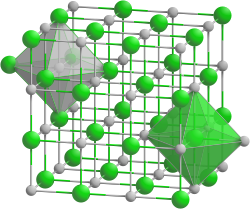Tantalum nitride
| Crystal structure | |||||||||||||||||||
|---|---|---|---|---|---|---|---|---|---|---|---|---|---|---|---|---|---|---|---|

|
|||||||||||||||||||
| __ Ta 3+ __ N 3− | |||||||||||||||||||
| General | |||||||||||||||||||
| Surname | Tantalum nitride | ||||||||||||||||||
| other names |
|
||||||||||||||||||
| Ratio formula | TaN | ||||||||||||||||||
| Brief description |
gray, odorless solid |
||||||||||||||||||
| External identifiers / databases | |||||||||||||||||||
|
|||||||||||||||||||
| properties | |||||||||||||||||||
| Molar mass | 194.96 g mol −1 | ||||||||||||||||||
| Physical state |
firmly |
||||||||||||||||||
| density |
|
||||||||||||||||||
| Melting point |
3360 ° C |
||||||||||||||||||
| solubility |
almost insoluble in water |
||||||||||||||||||
| safety instructions | |||||||||||||||||||
|
|||||||||||||||||||
| As far as possible and customary, SI units are used. Unless otherwise noted, the data given apply to standard conditions . | |||||||||||||||||||
Tantalum nitrides are ceramic compounds made from tantalum and nitrogen . They occur in several modifications and oxidation states (α-TaN, ε-TaN, Ta 2 N, Ta 3 N 5 , Ta 4 N 5 , Ta 5 N 6 ). The most commonly used is tantalum mononitride TaN. It is mainly used in chip production as a barrier and adhesive layer ( low-K dielectrics ), but is also used for high-precision thin-film resistors. In thick-film solar cells , tantalum nitride is used as a diffusion barrier. The material is applied by sputtering . Furthermore, tantalum nitride is used as a coating material in medical technology or in melting pots , as it is resistant to liquid actinide metals.
Extraction and presentation
Tantalum nitride layers can be produced in different ways. The currently most widely used method is the sputter deposition of tantalum in the presence of nitrogen ions (reactive sputter deposition). Research is currently focused on the deposition of tantalum nitride using chemical vapor deposition or atomic layer deposition . This requires organometallic reaction gases ( precursors ) that serve as a source of tantalum. A nitrogen source is also necessary, such as the very frequently used ammonia, which dissociates at the usual process temperatures of 200–400 ° C. However, there are also reaction gases such as TBTDET (tert-butylimido-tris (diethylamido) tantalum), which serves as both a tantalum and nitrogen source. In addition, there are countless other ways of producing tantalum nitride layers, such as the ion implantation of nitrogen in tantalum layers.
Tantalum (V) nitride Ta 3 N 5 as a valence-based, non-metallic nitride can be produced by reacting tantalum (V) oxide with ammonia or tantalum (V) chloride with ammonium chloride .
Individual evidence
- ↑ a b c d e data sheet Tantalum nitride, 99.5% (metals basis) from AlfaAesar, accessed on December 7, 2019 ( PDF )(JavaScript required) .
- ^ A b Dale L. Perry: Handbook of Inorganic Compounds . CRC Press, 2016, ISBN 978-1-4398-1462-8 , pp. 410 ( limited preview in Google Book search).
- ↑ Georg Brauer (ed.) U. a .: Handbook of Preparative Inorganic Chemistry. 3rd, revised edition. Volume III, Ferdinand Enke, Stuttgart 1981, ISBN 3-432-87823-0 , p. 1472.
literature
- Jens Baumann: Manufacturing, characterization and evaluation of conductive diffusion barriers based on tantalum, titanium and tungsten for the copper metallization of silicon circuits . Shaker, Aachen 2004. - ISBN 3-832-22532-3 ( Weblink to PDF , 45.38 MB)
Web links
- Binary nitrides of niobium and tantalum (PDF file; 4.6 MB)
